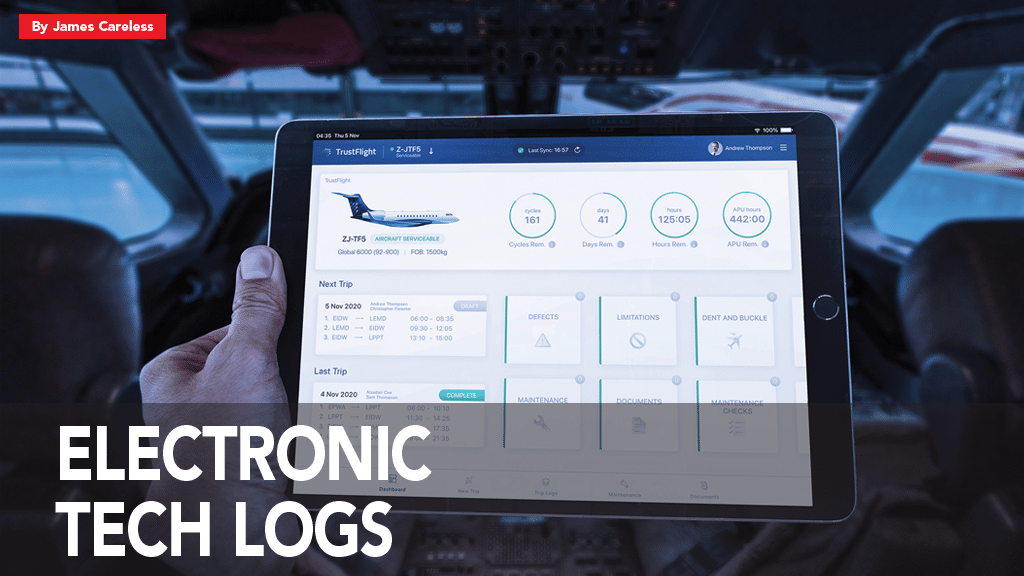Whether you call them Electronic Tech Logs (ETLs) or Electronic Log Books (ELBs), the use of digital devices/media for tracking the mechanical/electrical health of aircraft is revolutionizing the aviation maintenance business.
This is because “an ETL functions as a fully integrated technical, journey and cabin solution that is carried on each aircraft,” said Jack Clancy, UX/UI designer and sales manager with REDiFly, makers of the REDiFly ETL mobile app. “It holds the most recent status of the aircraft in terms of its current maintenance, as well as hours, cycles, fuel, approved signatures and more.”

To get a sense of how big a revolution this is, Aviation Maintenance spoke with ETL/ELB developers/vendors. Our takeaway: The sheer volume of advantages associated with migrating from paper to digitally-based maintenance tracking may well astound you.
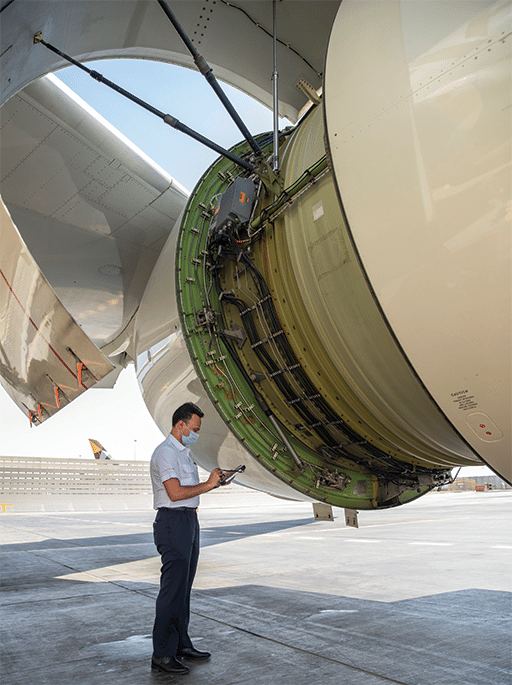
Better Aircraft Maintenance Management
The fundamental purpose of ETLs/ELBs — let’s call them ETLs for convenience’s sake — is to improve the quality of aircraft monitoring, maintenance, and repair management. On all of these points, ETLs definitely hit the mark.
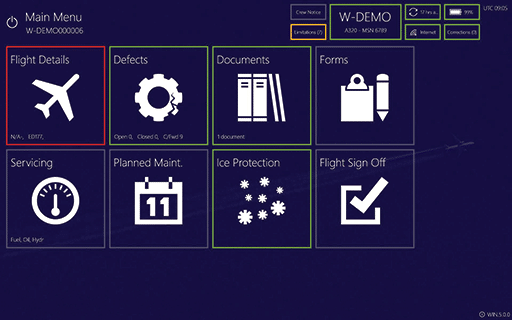
“There are numerous benefits for both airlines and MROs to incorporate an electronic tech log for maintenance” Clancy told Aviation Maintenance. For one thing, ETLs support the recording of real-time data such as the entry of flight hours, cycles, defects/MEL items, and service log data. For another, this maintenance data can be accessed quickly and easily by authorized personnel, even while the aircraft is in flight.
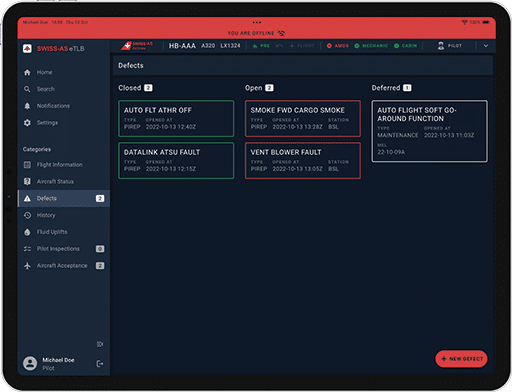
Taken together, this real-time data can be used by MROs to accurately schedule maintenance, optimize the coordinated availability of technicians, and provide complete transparency regarding tools, parts and warranties. In the repair shop, this improved planning process allows for simplified control of line items, decreases the risk of wrongly replaced parts, and enables faster turnaround times. As well, “the CAMO (Continuing Airworthiness Management Organization) department is informed of the ideal times to perform tasks,” said Clancy. Meanwhile, “it is always possible to see if an aircraft is serviceable but not released.”
Proactive Response to Maintenance
When airlines and MROs have regular access to the ETL-captured data outlined above, “it allows them to take a proactive approach to their work and prepare future ground maintenance tasks even during the flight,” said Mathis Even, product marketer with Swiss Aviation Software, makers of the tablet-based AMOSeTL ETL. “Additionally, aircraft mechanics do not need to go back and forth to the flight deck to report their actions into the paper-based Tech Log, because AMOSeTL can capture this data for them. We have also seen that the aircraft acceptance process is much smoother and safer when all data is dash-boarded and summarized for the pilot. He can immediately check if the aircraft is ready to be accepted.”
Over the long term, “obtaining aircraft performance data more efficiently allows the operator to make more proactive decisions based on real information,” said Paul Boyd. He is managing director of the Conduce Group, maker of the eTechLog8 ETL platform. “Software such as eTechLog8 guides users toward selecting the correct data entries as well as ensuring that all mandatory data is complete before data transmission into the airlines’ MCC/OCC departments. The increased consistency of data recording is also significant when you look at the use of this data in predictive maintenance models. In order for potential component failure predictions to be accurate, consistent and reliable data is required at the outset.”
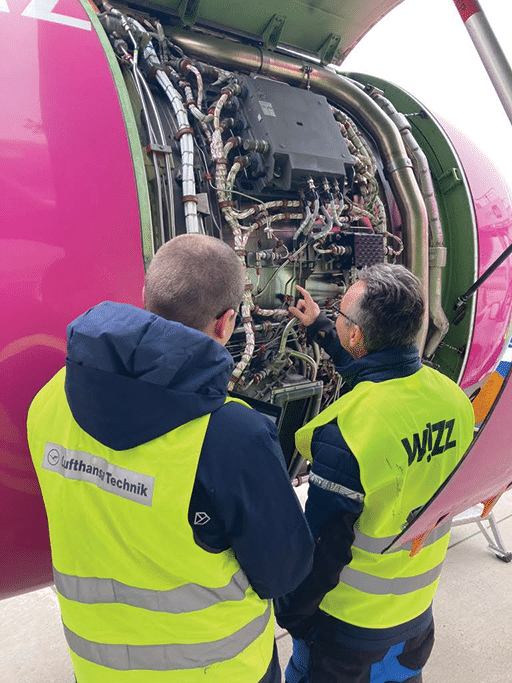
LHT image
Integration with Maintenance Software Systems
ETLs can be integrated with airline maintenance and flight operations in several ways, and be ported to these airlines’ MROs as well. This ensures that everyone involved in aircraft maintenance has the most up-to-date, accurate picture of what is happening with the aircraft in question, and thus the best chance to service it properly.
In addition, ETLs can be configured to send automatic alerts and notifications to relevant stakeholders when specific maintenance events or operational conditions occur. “For example, if an aircraft component reaches a predetermined threshold that indicates it requires inspection or replacement, the system can automatically notify maintenance crews, flight crews, and other relevant parties,” Clancy said. “Maintenance crews can also use the system to communicate with flight crews about the status of maintenance activities, while flight crews can use the system to provide feedback about any issues they encounter during flight.”
A case in point: “eTechLog8 was designed from the very first line of software code to be totally interoperable across the airlines’ systems,” said Boyd. “Conduce believes that the principle of collecting data once and using it multiple times is paramount. This essential maintenance data can be supported with additional metadata such as component change information, man-hour details, photos of defects and standardization using digitally interactive LOPA charts for cabin defects.
Simpler, More Accurate Process
There is no doubt that technical data recorded using an electronic keyboard will be more accurate than data written down by hand on paper. “Unreadable writing on paper and carbon copies often causes extra effort for maintenance personnel,” said Dajana Kunz, product lead of AVIATAR Technical Logbook, Lufthansa Technik’s ETL product. “A digital solution mitigates that extra work completely and frees capacities which can be utilized elsewhere. Even more so, the ETL’s direct connection to a maintenance and engineering software system saves the effort and time with additional manual entries. Best yet, the whole process of paper transport, scanning and archiving becomes obsolete, which is not only a financial but also an ecological advantage for the airlines using our electronic solution.”

TrustFlight
That’s not all: An ETL can simplify non-maintenance tasks such as the mandatory recording of an aircraft’s technical status prior to each flight. “A basic ETL solution will eliminate errors associated with handwriting legibility and calculation errors (e.g., for fuel uplifts),” Cameron Hood said. He is CEO of NVable Europe Limited, maker of the CONVERGE Electronic Techlog ETL. “Generally, they will also manage the time limitations associated with deferred defects and checks, making those limitations visible to both line engineers and maintenance control. Various other advantages can arise with the addition of damage charts, document management, and integration with operational data.”

Lufthansa Technik
In contrast, “paper logs are a time-consuming process to fill out as, for example, crew have to manually calculate the flight time,” said Karl Steeves, director of TrustFlight, an iPad-based ETL solution. “Once they are created on carbonized paper, they must be shipped to a records team to then be transcribed into multiple maintenance and operations systems. All of this takes a lot of administration time in an operation.”
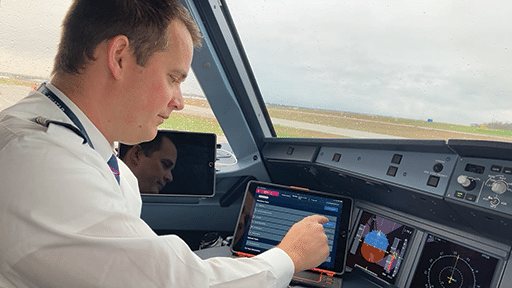
More Control
An ETL makes it possible for an airline to exert more control over various aspects of its business.
For example, when its data is ported to a web portal, the ETL provides near real-time visibility of an airline’s fleet status. “In turn, this allows for better planning and fewer unexpected issues, thereby increasing reliability,” Hood said. “These benefits accrue primarily to the airlines, but are ultimately beneficial to their passengers as well.” For instance, “airline passengers will benefit indirectly if technical problems can be solved faster/sooner e.g., through an advanced dispatch process, reducing technical delays,” said Kunz.
“An ETL provides instant visibility of faults on an aircraft, allowing quicker and better troubleshooting, ultimately reducing delay time,” agreed Steeves. “As faults are recorded as a digital record, they tend to be of better quality than those written down manually. This can lead to benefits when looking at reliability trending with respect to specific parts and/or aircraft.”
ETLs also provide enhanced control of access to aircraft technical logs, giving their operators a justifiable sense of confidence in their historical accuracy. This is because “an ETL provides more control around who is allowed to authorize sections of the technical log,” said Hood. “This ensures that pilots do not authorize a section that only a qualified engineer should be allowed to authorize, and vice versa. It also provides better control over third-party authorizations.”

NVable
Better Compliance
The airline industry has to deal with intense levels of scrutiny. Not only do they have to comply with a wide range of regulations in flying aircraft around the globe, they have to be able to prove this compliance before, during and after the fact.
There is no doubt that a digitally-based technical logging system is the best suited to show such compliance on a reliable and accessible basis. “Because these ETL processes are digital, there can be validations, checks and balances to ensure that all data recording processes are completed correctly and in compliance,” Steeves said. “For airlines, this provides a significant safety benefit as you avoid the risk of dispatching an unserviceable aircraft, for example. Of course, cost is also a big factor in all of the above benefits, in addition to reducing the amount of carbonized pads that have to be procured by the airline!”
Easy to Use
Beyond the advantages noted above, one standout fact about ETLs is that they are easier for pilots and technicians to use than paper-based systems. This is because ETL interfaces are designed to be intuitive and simple to work with. Being digital, they can also have their Help menus right at hand for users, avoiding the frantic ‘looking through the index’ associated with paper-based technical logs.

ULTRAMAIN
“Key ETL/ELB features such as predefined workflows, embedded MEL/CDL (Minimum Equipment List/Configuration Deviation List), predefined report trees and fault menus, graphical reporting and an intuitive UI all contribute to extremely high data integrity and ease of use,” observed Rob Saunders, director of business development with Ultramain Systems. (This company’s ULTRAMAIN ELB comes with an electronic journey log, integrated technical and cabin logs, a dent-and-buckle chart, eDocs and a Refuel Log among its ETL features.) “All of these things we talk about are designed to simplify the life of the user and make the hard stuff easier.”
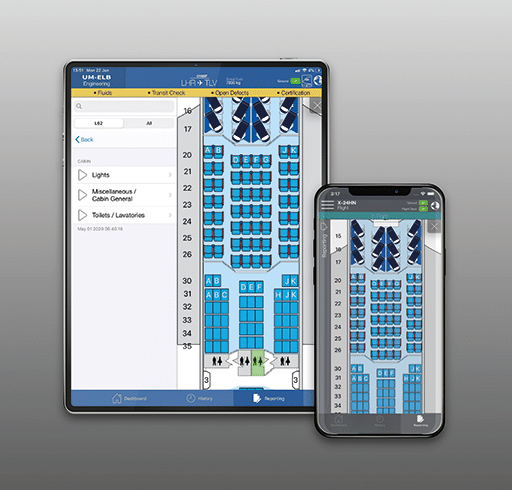
Solid Savings
When it comes to the cost and operational efficiencies associated with ETLs versus paper-based logging systems, “it is easy to see the savings on printing, distribution, collection, data entry, and records storage,” Saunders said. “However, the savings in paper replacement are minor compared to what can be achieved with an ETL that is designed to rationalize the line maintenance operations process. As well, with real-time accurate updates to the user’s management information system, no matter what system is in place, existing back-office processes immediately become more efficient.”
Adoption of ETLs is Slow
With all the benefits that we have enumerated with respect to ETLs in this article, one would expect this technology to be enjoying widespread adoption among airlines and MROs alike. But this isn’t the case. According to Karl Steeves, “adoption is still relatively low, with around 5-10% of operators using ETLs. We generally see the more forward-thinking and process-focused operators adopting these systems first. Often these are low cost carriers and ‘simpler’ single-fleet type operators.”
So why is the aviation industry reluctant to adopt ETLs across the board? “In the early days some vendors had several failed projects,” replied Boyd. “This is often the case with new technology that is being used to solve different issues.”
In recent years, ETLs have been adopted by several airlines including flag carriers, scheduled operators and ACMI capacity providers, he noted. “Conduce customers include the likes of Etihad Airways, Royal Brunei Airlines, Jazeera Airways, Titan Airways, SmartLynx Airlines, Avion Express, Texel Air and other international cargo operators,” said Boyd. Still, “The truth is that, across all ETL vendors, I suspect that the adoption rate is such that still only around 10% of the 30,000 or so commercial airliners operating have an ETL on board today.”
The laptop/embedded ETL options available at the turn of the millennium were limited and had their problems, Saunders added. “Laptops were slow to connect (if at all), while installed EFBs from the OEMs cost tens of thousands of dollars per aircraft, and each change would require Service Bulletin-type recertification,” he said.
Despite the challenges associated with those early ETL days, “leading innovators such as Cathay Pacific achieved groundbreaking achievements in e-enabled operations,” said Saunders. “In 2009 the first Cathay Pacific B777 was operated with STC-installed EFBs in the flight deck and cabin. The cabin device being used was the ULTRAMAIN eCabin log while the ULTRAMAIN eTech log was available on the three flight-deck EFBs.”
The introduction of the iPad a year later made it possible to load flight-related software on lightweight portable devices. These were quickly adopted by flight crews to serve as Electronic Flight Bags (EFBs), replacing the heavy bags of paper manuals they had to carry in the cockpit.
“E-tech logs were expected to follow,” Saunders said. “However, an aircraft maintenance log is not a flight ops document and has never been in a pilot’s leather flight bag. The user demographics are flight crew, cabin crew, and engineering. This fact, along with the slow acceptance of ETLs by regulators and a general underestimation of the complications of online/off-line application capabilities led to few successes over the last 10 years.” Meanwhile, over 1.5m electronically signed sectors later, ULTRAMAIN’s full suite ELB remains available with its aircraft systems integration capabilities.
Change is Coming
In recent years, the aviation industry’s cautious attitude towards ETLs has started to change, albeit slowly. “There are a few well-known maintenance companies that are now emerging with an electronic tech log solution, which is a telling sign that there is a growing demand in the market,” said Clancy. “However, progress takes time, and the aviation industry has been slow to respond to digitalization in the past. Compared with the advent of the EFB a few years ago, we are only now seeing an increased rate of global adoption for the electronic tech log, particularly among the larger scheduled carriers.”
The good news: “Currently we are seeing a major growth of interest of our customers to digitize their flight and maintenance operations,” Even said. “We even see that aviation customers who are purchasing and moving to AMOS today want to go live directly with fully paperless processes; including eSignature. We have ten funding customers who are supporting the final stages of development of our product (released in June 2023). They include low-cost and major airlines, flag carriers, and helicopter operators.”
Ultramain is seeing similar growth in ETL market acceptance. “ULTRAMAIN ELB is deployed and in paperless production use at ten airlines throughout the world with over 100,000 direct users using many different fleet types, both Boeing and Airbus,” said Saunders. “It is being used throughout their network of line stations worldwide by airlines and their third party maintenance providers. Our customers include Cathay Pacific Airways, Japan Airlines, British Airways, Air New Zealand, Airwork, Starlux, Air Hong Kong, Vistara and Scandinavian Airlines.
As these ETL vendors will tell you, the main obstacle blocking widespread deployment of their products is not their capabilities, but the reticence of airlines to take this step.
“There are no doubts about the benefits of an ETL,” said Hood. “The main obstacle is the airline making a strategic decision to implement it. The introduction of an ETL requires effort from the airline and some relatively intense engagement with the local aviation authority. It also inevitably leads to a reassessment of various procedures and realigning those to fit.”
“Conduce believes that there are no real obstacles to the adoption of an ETL,” Boyd agreed. “There are now enough successful implementations that should encourage other operators to look seriously at an ETL project. Obviously, you still need to evaluate the software solution options available and ensure the project is kept simple so that deliverables can be quickly identified and be successful. But Conduce has regularly seen project paybacks for many of its clients being achieved in only one year of operation.”
What’s to Come
Looking forward, airlines and maintenance operators can expect even more capabilities from the ETLs of tomorrow.
“We expect that, in the future, the tech log solutions will offer even more automation, connecting data from various sources and automatically giving recommendations or drawing conclusions based on them,” said Kunz. “The connection of different data points within the logbook will further enable entities to gain business intelligence, make users’ lives easier and enable them to take on new tasks using the logbook.”
“There will be more and deeper system integrations with increasing interchangeable access across multiple platforms such as Windows, iOS, and Android,” Hood predicted. “This will drive additional functionality that will be helpful on the line. Analysis of the stream of data collected will become more automated and intelligent, potentially integrating aspects of machine learning or artificial intelligence. And the onboarding process will become smoother, because our ultimate aim is to allow airlines to ‘self-serve’ the entire ETL process.”
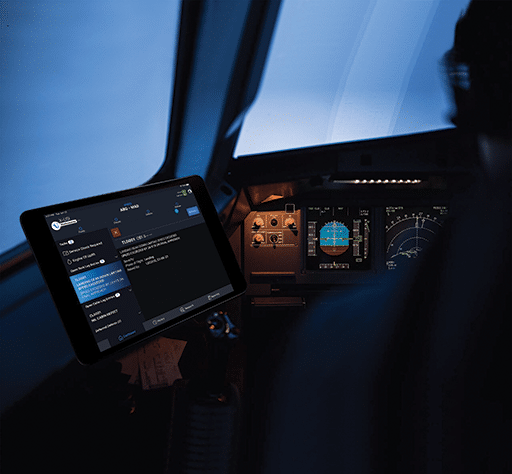
“There are many developments in Aviation IT such as Blockchain, AI (Artificial Intelligence) and Predictive Analytics, all of which we are interested in,” concludes Clancy. “However, for small to medium operators, these concepts may still be a while down the road. So, I believe the future of ETL technology lies in the flexibility of the software and for digital aviation vendors like ourselves to provide a more informative and accessible landscape for the operators we cater for.”
